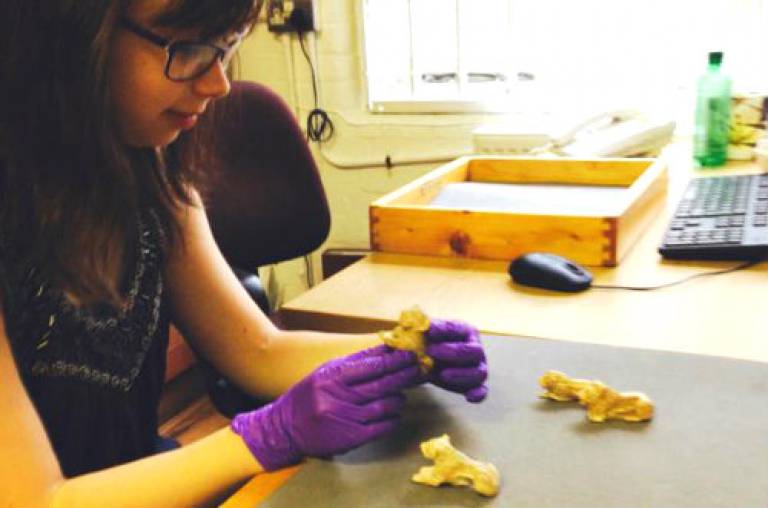Using museum collections to improve the student experience
Two second-year undergraduate students spent a week as interns in the UCL Petrie Museum of Egyptian Archaeology.

15 June 2016
Dr Alice Stevenson (Curator, UCL Petrie Museum of Egyptian Archaeology) explains how two undergraduate internships at one of the university’s museums have helped staff to explore how learners of any discipline might engage with object-based research and learning.
Testing using collections to teach students from different disciplines
In July 2015, two second-year undergraduate students spent a week in the UCL Petrie Museum of Egyptian Archaeology with a grant from the UCL Arena Centre for Research-based Education.
The students assisted a three-year AHRC research project ‘Artefacts of Excavation: the international distribution of finds from British excavations in Egypt 1880-1980’. The project, led by Petrie Museum curator Dr Stevenson in partnership with the University of Oxford, uses the museum’s collections to examine the history and politics of the excavated material found during the hundred-year period.
The internships were an opportunity to improve the student experience of working with UCL collections and to see what the potential barriers and benefits there might be for those without specialist knowledge.
One of the students came from the Archaeology department and was undertaking the module ‘Archaeology of Egypt’ and another was from the Department of Geography and was taking the module ‘Cultural and Historical Geography’.
Understanding how students and staff use collections in teaching
Museum collections are often used in UCL classes, but curators don’t often get the opportunity to help with modules or receive feedback.
The internships provided an opportunity for museum staff to better understand how students and staff use the collections in their teaching and learning and to explore how well undergraduate modules prepared students for undertaking research.
It also helped the team to think about how they might strengthen teaching and learning opportunities between UCL Museums and Collections and other UCL academic departments.
Students were not prepared for the realities of research
The internships were useful in identifying themes in students’ learning experiences.
Both students reported that collections-based case studies in lectures were often presented as well-rounded results, but they found this to be unrepresentative of research with objects.
They commented that they felt ill-equipped to deal with uncertainties before the internship. It showed that more emphasis was needed on the realities of research.
It was also clear that students need some form of accessible orientation when coming to a collection in order to prompt deeper engagements.
Students sharing their experiences and how they gained confidence to conduct research
To address this both students wrote introductory guides to the Petrie collection for their peers based on their experience. These were then shared on Moodle for the benefit of the next academic year’s cohort so they could use it before undertaking their own collection-based assignments.
Bryony Smerdon, the Archaeology undergraduate intern, said:
“I felt better prepared to undertake my own research… looking at a wider picture has given me a much better appreciation and more context for the course material and objects of focus in my degree”.
Bryony subsequently used the Petrie museum and the AHRC research project as the basis for her 3rd year dissertation which has informed her decision to continue with the subject to Master’s level.
Geography undergraduate Milena Petrovic felt the experience has given her greater confidence to undertake research.
Strengthening links between museum and department
The internships project has led to new teaching links with both the Geography and Archaeology departments.
The Petrie Museum will contribute to the 3rd year Geography Independent Study module through two placements, using the lessons from Milena’s internship to steer the types of projects available to students, and the entire Archaeology of Egypt module ran within the Petrie Museum in 2015-16 for the first time, using sets of objects suggested by the Egyptian archaeology intern, Bryony.
Student feedback at the end of the academic year was extremely positive. One student said: “The handling of artefacts was an amazing experience and having the Petrie Museum as a lecture hall was brilliant.”
The museum now plans to approach other departments and roll out student-centred guides on how to research the collection from a range of disciplinary perspectives.
 Close
Close

